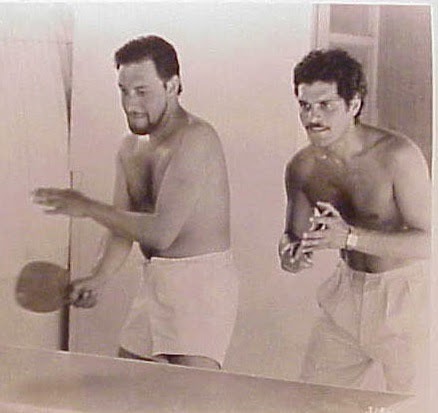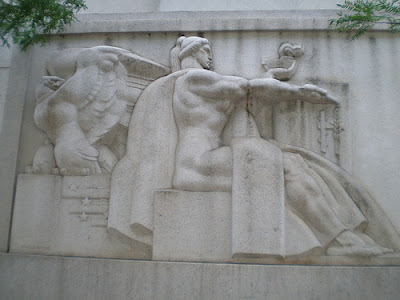When I was a kid in the 1960s, our newspaper, The Rock Island Argus, had several interesting columns: Dear Abby, a criptoquip, and "Omar Sharif on Bridge."
Nazarenes weren't allowed to play cards, so I was only barely aware of what bridge was. Still, it seemed exciting that a famous actor would stoop to writing about something so mundane as a card game.
Born in 1932 in Egypt, Sharif got his degree in physics before becoming an actor. He starred in many Arabic movies before hitting Hollywood with a starring role in Lawrence of Arabia in 1962. A rarity in its day (and even now), the movie fails to heterosexualize the gay T.E. Lawrence, and even gives him a gay-subtext relationship with Arab leader Sherif Ali (Sharif).
Next came starring roles in the big-budget epics Doctor Zhivago (1965) and Genghis Khan (1965), plus dramas, Westerns, and musicals. He played revolutionary leader Che Guevara (Che!) and the mysterious Captain Nemo (The Mysterious Island).
This nude scene is from the Western MacKenna's Gold (1969). He plays an effervescent but amoral Mexican outlaw named John Colorado, who doesn't display any interest in women.
He became best friends with French actor Jean-Paul Belmondo after they starred together in Le Casse (The Burglars, 1971), as a jewel thief and the corrupt cop who wants his share of the loot.
By the way, bridge was not only a hobby for Sharif, it was a second career.
I don't know if he was gay-positive or not, but his grandson, Omar Sharif Jr. is gay. Also an actor, he left Egypt in 2012 after the restriction of human rights, and came out in an article in The Advocate.
Beefcake, gay subtexts, and queer representation in tv and other pop culture from the 1950s to the present
Apr 28, 2018
Apr 26, 2018
Donald De Lue and the Male Nudes of Public Art
The Boy Scout Memorial, on the Ellipse in Washington DC, gives visitors quite an eyeful. A muscular man who has apparently just stripped is walking beside the boy scout.
He represents nothing more arcane than "American Manhood." There's a fully-clothed woman, also, representing "American Womanhood."
It is particularly surprising because it was sculpted in 1963, when male nudity was not commonplace in public art, even with the penis covered.
The sculptor was Donald De Lue (1897-1988), who grew up in Boston and studied in Paris, like many artists of his generation. After eleven years as assistant to sculptor Bryant Baker, he pushed out on his own, specializing in public art.
Stately, muscular male nudes, gods and other mythological and allegorical figures.
Like this Babylonian-style frieze "Law and Justice," on the Federal Building in Philadelphia, is from 1941, just before the U.S. entered World War II.
Or The Rocket Thrower, created for the 1964 World's Fair, now at Flushing Meadows-Corona Park in Queens, New York.
Among his most famous sculptures is The Spirit of American Youth Rising from the Waves, in the American Cemetery at Normandy (1956).

Most of his public art hides the penis, but his smaller pieces don't. The Sun God (1937) is now at the Dallas Museum of Art.
Icarus (1934) is at the Smithsonian.
Of course, drawing artistic inspiration from the bodies of naked, muscular men doesn't necessarily mean that you are gay. But it doesn't mean that you are straight, either.
He represents nothing more arcane than "American Manhood." There's a fully-clothed woman, also, representing "American Womanhood."
It is particularly surprising because it was sculpted in 1963, when male nudity was not commonplace in public art, even with the penis covered.
The sculptor was Donald De Lue (1897-1988), who grew up in Boston and studied in Paris, like many artists of his generation. After eleven years as assistant to sculptor Bryant Baker, he pushed out on his own, specializing in public art.
Stately, muscular male nudes, gods and other mythological and allegorical figures.
Like this Babylonian-style frieze "Law and Justice," on the Federal Building in Philadelphia, is from 1941, just before the U.S. entered World War II.
Or The Rocket Thrower, created for the 1964 World's Fair, now at Flushing Meadows-Corona Park in Queens, New York.
Among his most famous sculptures is The Spirit of American Youth Rising from the Waves, in the American Cemetery at Normandy (1956).

Most of his public art hides the penis, but his smaller pieces don't. The Sun God (1937) is now at the Dallas Museum of Art.
Icarus (1934) is at the Smithsonian.
Of course, drawing artistic inspiration from the bodies of naked, muscular men doesn't necessarily mean that you are gay. But it doesn't mean that you are straight, either.
Apr 23, 2018
10 Black Guys in Bondage
If you are attracted to black men and to men in bondage, why not combine the two?
It's not that easy. There are very few gay black men into BDSM, and those few are usually tops. After years of collecting, I have only about 100 photos and videos, and those are mostly movie caps.
Here are my favorite non-movie photos of black men in bondage.
1. Nice biceps and abs on display.
2. The cropping is a little off, but you can't complain about that sculpted physique.
3. Two guys together is always hotter than a guy alone.
4. Where to classify him: black men, bondage, or men in suits?
5. The red shorts contrast beautifully with the gleaming abs.
More after the break.
6. Arms behind the back, and a camouflage jockstrap.
7. Not very muscular, but have you ever seen such long arms?
8. Mature men in bondage.
9. Massive chest.
10. Spreadeagle on the bed.
It's not that easy. There are very few gay black men into BDSM, and those few are usually tops. After years of collecting, I have only about 100 photos and videos, and those are mostly movie caps.
Here are my favorite non-movie photos of black men in bondage.
1. Nice biceps and abs on display.
2. The cropping is a little off, but you can't complain about that sculpted physique.
3. Two guys together is always hotter than a guy alone.
4. Where to classify him: black men, bondage, or men in suits?
5. The red shorts contrast beautifully with the gleaming abs.
More after the break.
6. Arms behind the back, and a camouflage jockstrap.
7. Not very muscular, but have you ever seen such long arms?
8. Mature men in bondage.
9. Massive chest.
10. Spreadeagle on the bed.
Maxwell Caulfield: Responding to Gay Rumors with Homophobia
Have you heard of Maxwell Caulfield? During my senior year in college, he was being hailed the Next Big Thing.
Born in Scotland, Caulfield moved to London at age 15 and became a nude dancer at the infamous Windmill Cinema. At age 18, he came to the U.S., and quickly got cast in the gay-themed stage farce Hotrock Hotel (1978), then the gay-themed Entertaining Mr. Sloane (1981), by Joe Orton.
In 1982, he won out over thousands of hopefuls to star in the sequel to Grease, the most popular movie musical of all time.
Grease 2 premiered in June 1982 to a huge hype campaign.
The box office wasn't exactly miserable, but it didn't match expectations by a long shot.
Singing "Rock-a-Hula Luau" was not exactly helpful to Caulfield's career.
In the homophobic 1980s, the gay rumors didn't help, either.
He starred in a few horrible-sounding tv movies, such as Electric Dreams (1984), about a guy and a computer both in love with the same woman, and The Supernaturals (1986), about an army of dead Confederate soldiers still fighting the Civil War.
And The Boys Next Door (1985), an intensely homphobic movie in which a straight guy (Caulfield) is lured into a mass-murder spree by his closeted-gay friend (future jerk Charlie Sheen) go on a killing spree because, of course, gay people are all psycho killers waiting to happen.
It could also be read as a commentary on Caulfield's career: "Look, I was lured into playing those gay roles by evil gay producers. It's not my fault."
He spent two years playing Miles Colby in the Dynasty spin-off The Colbys (1985-87).
Then it was back to bad, ridiculous, or homophobic movies.
Mind Games (1989): a couple goes camping, and encounters a psycho (Colby) who has sinister designs on their son.
Dance with Death (1992); Murders at a strip club.
Animal Instincts (1992): Porn.
He's been more successful on stage, with starring roles in Joe Orton's Loot, Tryst, Cactus Flower, female impersonator Charles Busch's Our Leading Lady, and Chicago.
Born in Scotland, Caulfield moved to London at age 15 and became a nude dancer at the infamous Windmill Cinema. At age 18, he came to the U.S., and quickly got cast in the gay-themed stage farce Hotrock Hotel (1978), then the gay-themed Entertaining Mr. Sloane (1981), by Joe Orton.
In 1982, he won out over thousands of hopefuls to star in the sequel to Grease, the most popular movie musical of all time.
Grease 2 premiered in June 1982 to a huge hype campaign.
The box office wasn't exactly miserable, but it didn't match expectations by a long shot.
Singing "Rock-a-Hula Luau" was not exactly helpful to Caulfield's career.
In the homophobic 1980s, the gay rumors didn't help, either.
He starred in a few horrible-sounding tv movies, such as Electric Dreams (1984), about a guy and a computer both in love with the same woman, and The Supernaturals (1986), about an army of dead Confederate soldiers still fighting the Civil War.
And The Boys Next Door (1985), an intensely homphobic movie in which a straight guy (Caulfield) is lured into a mass-murder spree by his closeted-gay friend (future jerk Charlie Sheen) go on a killing spree because, of course, gay people are all psycho killers waiting to happen.
It could also be read as a commentary on Caulfield's career: "Look, I was lured into playing those gay roles by evil gay producers. It's not my fault."
He spent two years playing Miles Colby in the Dynasty spin-off The Colbys (1985-87).
Then it was back to bad, ridiculous, or homophobic movies.
Mind Games (1989): a couple goes camping, and encounters a psycho (Colby) who has sinister designs on their son.
Dance with Death (1992); Murders at a strip club.
Animal Instincts (1992): Porn.
He's been more successful on stage, with starring roles in Joe Orton's Loot, Tryst, Cactus Flower, female impersonator Charles Busch's Our Leading Lady, and Chicago.
Labels:
gay character,
homophobia,
horror,
nudity
Subscribe to:
Comments (Atom)























